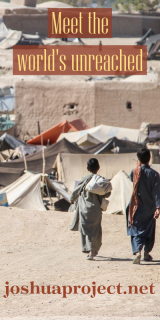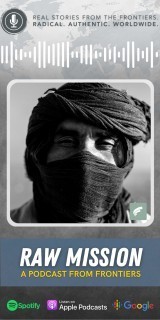Editorial Comment

Monday, October 23, 1995 I am scared to death of two tragic possibilities, no three.
First, as I write these words in this editorial (in the first-ever issue of Mission Frontiers edited entirely by people not on our staff) I am seriously concerned that the stark, astounding significance of the movement described here will be vastly underestimated by preoccupied believers-like the maidens who ran out of oil, or worse still, like the people who didn't take Noah seriously (As is the days of Noah…). This issue is only the tip of the iceberg of AN INCREDIBLE NEW FACTOR that explodes all previous estimates of what can be done by the year 2000.
Secondly, I am scared stiff that this atomic explosion of global interest in completing the task of Global Mission will go wrong in several ways.
Thirdly, I am afraid that despite all of the careful explanations, the important linking of the smaller list published in this issue (part of a larger list) is not going to be easily understood. Yet it is very important how this list leads to other smaller groups of people, and how mission strategy may often begin with the smaller fragments of the peoples listed here. Read on.
1. Fear One: Underestimating the hand of God
O.K, people may say, so what if 60,000 university students in Korea get all excited about missions?
Well, you know students everywhere…they are our true world citizens. They are eager to keep up with the students in other countries. In 1996 we may see not just students in Korea rising to the challenge, but students around the globe also putting their shoulders to the task.
Next year is an Urbana year, and even before the GCOWE meeting in Korea, Urbana leaders were planning to link up by satellite with other large student meetings around the world. And, read what this issue says further on: already the Brazilian students are determined to follow the Korean example. Already the South African students have stood up to be counted.
The events presented in this issue of Mission Frontiers if rightly understood, constitute not just a Korean oddity but a global reality! They are a series of amazing and unpredicted events which, linked to the Joshua Project, force a transformation of all previous estimates of the remaining task!
It is not as though we are predicting the time it takes for an underpowered car to make it up a long steep grade. The "car" of global Christianity today is twenty times as powerful as it needs to be to climb the grade in good time. It simply has not been running on all cylinders. Where I meet pessimism is often when people whose work contributes little to the countdown condone their lack of involvement by saying "the task is now impossible."
But, do you know? Those students in Korea were the sparkplug to generate all those millions that carried that amazing global gathering in May into the black. In fact, they still have a surplus of $2 million with which to be serious about the 60,000 commitments that were made.
Furthermore, those Korean students are the basis for a new wave of unprecedented collaboration in Korea. Thomas Wang and I addressed their huge "Mission Korea" meeting four years ago-and we were amazed to see all of the different student traditions, IVCF, CCCC, Navigators, Operation Mobilization, etc., cooperating together! Dear reader, pray that God will not allow you to underestimate Him in this hour of opportunity!
2. Fear Two: Will fools rush in where angels fear to tread?
But there are real dangers. I have taught the story of Christianity for many years. I recall many times down through history when explosions of renewal have taken place. Alas, it does not always turn out well.
We don't usually talk in public about all of the gross mistakes tourist type visitors to the mission field have made. Brief, superficial trips spurred on by the sense of adventure and travel more than deep concern for the Spiritual realities don't always help. In some cases all we really see accomplished is the realization that good intentions are not good enough.
With the proper preparations and cautions from veteran workers a lot of great good can be done by both pure-hearted Prayer Walkers and "On- site-investigators." But real damage is also possible without great care. Casual, minimal knowledge may be "the little knowledge which is a dangerous thing."
Take one simple problem: people may easily assume that mission work can be done by using ordinary evangelistic methods.
If masses rush into mission fields to finish the mission task, the real danger is that they will tend to use tried and true evangelism concepts, drawing understandably on their experience witnessing in their own culture. But Hindus who already expect reincarnation may be confused by talk about being "born again." We can't assume our way of explaining things back home will make sense in an exotic, little- understood unreached people. Cross-cultural mission requires something that is not immediately apparent.
3. Fear Three: Misuse of the list of peoples in this issue
POINT ONE: Be sure to read Dan Scribner's three-page explanation of the list (on pages 12-14). Note how many other people Dan mentions for the results published on pages 17-23. Note the many precautions and provisos he gives, which I do not need to repeat here. Also note his statement that "groups with populations below 10,000 will be considered in future revisions of this list." I'll bring this up in a moment.
POINT TWO: Sources. The most reliable sources are field missionaries, but they are not everyplace. Barbara Grimes of Wycliffe, editor of the Ethnologue, has undoubtedly spent more time across the years than any other person drawing information from the formidable human distribution of Wycliffe's 6,000 personnel scattered around the globe, but even that kind of coverage leaves gaps where government statistics must ultimately be consulted. However, some governments don't pay much attention to minorities. Others, like Australia, lists groups even less than 10 in population! In some cases, as with Jews and Turks, exhaustive studies were available, and so, of course, they show up in many countries!
POINT THREE: What about a larger list including groups smaller than 10,000? This is coming, Dan says, but what will it mean? First of all, the smaller groups are very numerous! The graph to the right portrays the fact that the smaller the groups the larger the number of such groups, logically enough. In this particular Southern Baptist list of 10,493 peoples, the groups less than 10,000 in population number only 5,647, but if all governments listed smaller groups there might be 20,000 since three out of four governments do not bother to report smaller groups.
But the most important reason for those adopting peoples on the present list is the amazing rule of thumb that missionary breakthroughs are more likely to succeed in smaller rather than larger groups!
Suppose a church, working with a mission agency, wants to help reach the Pathans, the legendary people of the Khyber Pass between Pakistan and Afghanistan. The heartland of this cluster of peoples (speaking various dialects of Pashto) is Afghanistan (page 17), where you'll see 12 million listed, and across the border in Pakistan (on page 21) you'll see 11 million Eastern Pathans plus 7.4 million Southern Pathans. But neither Afghanistan nor Pakistan are very easy places to work on Pathans. You will find thousands more in Iran, United Arab Emirates (two different groups), and the United Kingdom, on pages 20 and 23, respectively. The 87,000 in Great Britain are less than 1/3 of one percent, yet there are some Christians among them--who do not need to live in fear of the British government harassing them. And there might be some highly educated people who are already open to the Gospel who could participate in a powerful colloquial translation of key portions of the New Testament. You could not pursue that course readily in either Afghanistan or Pakistan where many of the main body of Christians look down on the Pashto-speaking "border people." No wonder 30 million Pashto speakers are still awaiting an effective translation--and a virile church movement!
POINT FOUR: This list is a list of serious, sensitive peoples, often where missionaries are already at work locally.
A close friend who has been among the Pathans for over ten years tells me about an outside group that was trying to raise $70,000 to pay for a study of the Pathan situation, ignoring the enormous efforts of past (and present) missionaries.
In other words, the list of "target" peoples must not mean we "shoot at" these peoples with naive, outside efforts. I heard the other day about a certain church that "adopted" a specific people and poured an enormous amount of study into the situation, even sending church members to scout out the group. But they did not know that an outstanding missionary-professor had written an entire book on that group after working among them for many years.
POINT FIVE: As we approach the historic completion of all the necessary mission breakthroughs the casual terminology we have often used in the past will need to give way to more precise language. We used to say we wanted "to win the world to Christ" without bothering to think concretely about what that would entail.
Preparing the Gospel FOR every person in a group is a mission task of accomplishing the very complicated goal of making sense in every strange group, establishing a church movement into which people can belong without leaving their people and their culture. Then the Gospel can be taken TO every person--in evangelism.
Once a group on this list is chosen the next thing is to know where all similar groups are to be found. To do that you may wish to order 1) a copy of this list sorted out by language rather than by country, and 2) the larger list of 10,493 peoples which includes groups smaller than 10,000 but which may speak the same language as groups in this list. If so, send $2.50 to me at the address below for these two additional lists. However, you can get all of this and much more on six IBM disks for $15 from John Gilbert-see his address on page 14.







comments